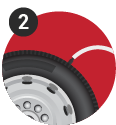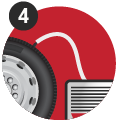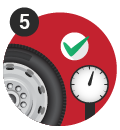TPMS and Tire Pressure Explained
21st Jun 2016
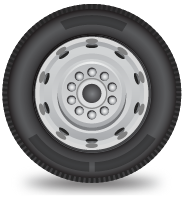
In the late 1990s, the Firestone tire company ran into a bit of a problem. A defect in their tires, particularly those for SUVs, were exploding , even at somewhat normal highway speeds. Vehicular deaths were directly connected to the problem, but helped raise a more pressing question. How is a driver supposed to know when they’re at risk of a severe and potentially dangerous tire blowout? The answer was the Transportation Recall Enhancement, Accountability and Documentation (TREAD) Act. The TREAD Act requires all vehicles under 10,000 pounds to have Tire Pressure Management Systems installed. Since 2008, 100% of all new vehicles have the system installed.
TPMS, Defined
A Tire Pressure Management System, or TPMS, is a safety feature designed to warn drivers when any of their tires has low pressure. A TPMS system is an issue of information and safety. Low tire pressure can result in a dangerous tire blowout. A check tire pressure light won’t go off without reason. When a tire explodes causes the vehicle to lose stability. This can cause the car to go out of control -- or so our brains lead us to believe. The reality is that during a tire blowout, the car will lose stability, but it will not do something so dramatic as flip over head over heels as we so often see in movies. In most cases, you can control a tire blowout simply by doing nothing, letting the car slow down on its own and avoiding turning the wheel.
The Tire Pressure Light
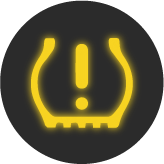 There are two types of TPMS systems: direct and
indirect. The direct system uses sensors and an RFID device to directly measure
the exact air pressure for each tire. This system sends data to your onboard
computer. The indirect system is software based. Instead of directly measuring
your car’s tire pressure, it software to determine how quickly each tire is
spinning in relation to the others. It uses this information to calculate the
possibility that a tire has low pressure, and send a warning to the onboard
computer.
There are two types of TPMS systems: direct and
indirect. The direct system uses sensors and an RFID device to directly measure
the exact air pressure for each tire. This system sends data to your onboard
computer. The indirect system is software based. Instead of directly measuring
your car’s tire pressure, it software to determine how quickly each tire is
spinning in relation to the others. It uses this information to calculate the
possibility that a tire has low pressure, and send a warning to the onboard
computer.
In both cases, if there is low tire pressure you will see the check tire pressure light stay on. If you see that the check tire pressure light keeps coming on, don’t ignore it!
Tire Pressure: It’s More Than Just Energy Efficient
We’ve all heard that properly inflated tires help with fuel efficiency . But saving a few dollars every year in gas is not the most important concern with tire inflation. It’s all about safety. Think of your tires like a balloon. Over inflating them and under inflating them can cause problems. In either case, you can end up with the same situation: a ruined tire.

Overinflating your tires means that more of the tire’s center is hitting the road than should be. The center part will protrude, resulting in very uneven wear. This means you’ll get less life out of your tires It could lead to dangerous wear on the tires and a blowout. Because your tires are rated for carrying a certain amount of weight at the proper inflation level, overinflated tires are at a higher risk of a blowout as well. Like a balloon, they’re ready to pop at a moment’s notice.

As we’ve already stated, low tire pressure can also result in dangerous blowouts. Under inflating your tires can be a direct cause of this. It’s important that when you are inflating your tires that you use a tire pressure gauge to determine your pressure level. Tire pressure is measured in pounds per square inch (psi). The best psi for each vehicle psi is determined by the manufacturer, and is based on the weight of the vehicle and how much weight it is intended to carry. In most cases, this number is actually located on the inside area of the driver’s side door.
When You’ll Know It’s Working
There are different ways to tell if your TPMS system if working or not. If your check tire pressure light stays on, this means that you have one or more tires with low tire pressure. You should pull over to the side of the road immediately and use the best tire gauge you have to determine your pressure level.

If your TPMS light goes on and off, this could indicate that your TPMS system is malfunctioning. Generally, this means that the light turns on, flashes for about one second, then turns off for another 3 seconds. This process will repeat. You can still use a tire pressure checker to determine if your tire pressure is low. However, if you discover that your tire pressure is fine, this means you will need to get your TPMS serviced.
In all cases, if your TPMS system comes on, you should use a tire pressure gauge to check the pressure. This is immensely important if the TPMS comes on while you are driving. Whether it is a
TPMS failure warning or the light comes on and stays on while you are driving, it is better to be safe than sorry.
No Technology Is Perfect. Including TPMS
It’s important to note that no technology is without its flaws. Even a TPMS system, which is required by law, may falter. The indirect TPMS system can be highly inaccurate at times, giving very false warnings of low tire pressure while also failing to indicate low tire pressure at other times. The more accurate direct TPMS system will rarely give false psi warnings. However, direct TPMS systems are battery operated. The batteries should last 5-10 years. If it’s been some time since you have replaced your battery, your TPMS battery may be dead, meaning you won’t get any information. And because the direct TPMS uses RFID to send information to the onboard computer, its signal can get blocked or misdirected for various reasons.
How to Check Your Tire Pressure
Checking your tire pressure is simple. Whether or not your TPMS is flashing off warnings, it’s best to go ahead and check your tire’s psi.
- First, gather the needed materials: a tire pressure gauge, pen and paper to record the psi of each tire, and an air compressor in case you need to fill up a tire with some more air.
- Only check your tires when they are “cold”. This means checking them when the car has not been moving for a while. The best time is in the morning, or after the car has been sitting unused for a several hours.
- Check the recommended psi for each tire. Remember that this information is in the doorjamb of the driver’s side door. Back and front tires usually have a different psi recommendation. Write these numbers down.
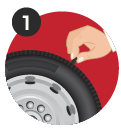
|
1. Unscrew the cap on the tire stem (if there is one). |
|
|
2. Attach the tire pressure checker to the air stem. Hold it for a few seconds without letting air out. This will give you the psi. |
|
|
3. Do this for each tire, recording the numbers. |
|
|
4. If any tire is below the recommended level, use the air compressor to fill the tire. |
|
|
5. Check the psi levels for any tires you have just refilled. |
The Pressure’s On!
Tire pressure is thankfully a simple, yet immensely important part of regular car maintenance. As long as you keep your tires at the recommended level regularly, you will almost certainly avoid a dreaded blow out. Always make sure that your TPMS system is working, and if you do see a warning, don’t panic! Pull over, check your tire pressure levels with your tire pressure gauge, and fill any tires as necessary. Check out this infographic on tire safety 101:
We are giving away two Astro Pneumatic Tire Inflators that can inflate, deflate, and measure tire pressure. Giveaway runs until 6/28/2016. Enter here: https://www.jbtoolsales.


